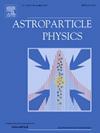候选黑洞吸积流和质量吸积率/波动的研究马克西j1535 - 571
IF 2.9
3区 物理与天体物理
Q1 ASTRONOMY & ASTROPHYSICS
引用次数: 0
摘要
MAXI J1535-571经历了剧烈和短暂的爆发,并伴有吸积流。硬x辐射是由于高温电子对软光子的热复合和逆复合而产生的。吸积流速率组分的变化/波动及其在不同时期的x射线辐射/通量变异性贡献推断了光谱状态。在这项研究中,我们利用了三个x射线任务/探测器(MAXI/GSC, NuSTAR和SWIFT/BAT)在相同和/或接近时期观测到的MAXI J1535-571数据。使用HEASoft v6.28及其软件包,以及每个检测器的标准流水线产品软件,分别对每个检测器的数据进行简化和分析。随后,将MAXI J1535-571数据同时在XSPEC 12.10.1f版本中进行拟合,并使用所选的分析模型和现象学模型(AP-model)进行建模,以研究光子指数- nbmc饱和效应和吸积流量分量的变化。利用TCAF模型对MAXI J1535-571数据进行分析,确定吸积流量各分量的相关性。AP -和tcaf -模型具有统计学上可接受的拟合,减少的卡方值≤1.2,并对其光谱结果进行比较。最佳拟合光子指数为~ 2.0 ~ 2.20,表明MAXI J1535-571处于上升相;硬中间态。质量吸积率的相关性表明,它们的变化/波动可能是吸积流的动力学和几何形状的原因。本文章由计算机程序翻译,如有差异,请以英文原文为准。
On the accretion flow and mass accretion rates/fluctuations in black hole candidate; MAXI J1535–571
MAXI J1535–571 underwent dramatic and transient outbursts accompanied by accretion flow. Hard X-radiations are produced due to thermal–and inverse–comptonization of soft photons by high-temperature electrons. The variations/fluctuations of components of the accretion flow rates and their fractional X-ray emissions/flux variability contributions at different epochs infer the spectral states. In this study, we utilized MAXI J1535–571 data observed by the three X-ray missions/detectors (MAXI/GSC, NuSTAR, and SWIFT/BAT) on the same and/or close-in epochs. Each detector's data were separately reduced and analyzed using HEASoft v6.28 and its software packages alongside the standard pipeline product software of each detector. Thereafter, the MAXI J1535–571 data were simultaneously fitted in XSPEC version 12.10.1f and modelled using selected analytical and phenomenological models (AP-model) to examine the photon index–NBMC saturation effect and variations of components of the accretion flow rates. Moreover, the TCAF model was used on MAXI J1535–571 data to determine the correlation of components of the accretion flow rates. The AP– and TCAF–models gave a statistically acceptable fit with a reduced Chi-squared value of ≤ 1.2, and their spectral results were compared. The best-fit photon index of ∼ 2.0–2.20 affirms that MAXI J1535–571 is in its rising phase; the hard-intermediate state. The correlation of mass accretion rates suggests that their variations/fluctuations could be responsible for the dynamics and geometry of the accretion flow.
求助全文
通过发布文献求助,成功后即可免费获取论文全文。
去求助
来源期刊

Astroparticle Physics
地学天文-天文与天体物理
CiteScore
8.00
自引率
2.90%
发文量
41
审稿时长
79 days
期刊介绍:
Astroparticle Physics publishes experimental and theoretical research papers in the interacting fields of Cosmic Ray Physics, Astronomy and Astrophysics, Cosmology and Particle Physics focusing on new developments in the following areas: High-energy cosmic-ray physics and astrophysics; Particle cosmology; Particle astrophysics; Related astrophysics: supernova, AGN, cosmic abundances, dark matter etc.; Gravitational waves; High-energy, VHE and UHE gamma-ray astronomy; High- and low-energy neutrino astronomy; Instrumentation and detector developments related to the above-mentioned fields.
 求助内容:
求助内容: 应助结果提醒方式:
应助结果提醒方式:


